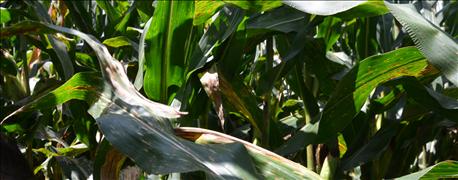August 22, 2016

Rains through summer have been a blessing, but along with excess moisture comes disease pressure. We’ve seen many corn hybrids hold back disease very well, but in the last few days, many diseases such as gray leaf spot have started moving quickly up plants.
Here are scouting tips for this week based on what we’ve seen recently.
1. Walk cornfields to look for disease.

DISEASE RAMPS UP: Favorable weather is helping disease like gray leaf spot gain a foothold in susceptible hybrids late in the season.
Determine corn growth stage and how much disease is present. If you’re nearing dent stage, it most likely won’t return enough bushels to justify spraying for disease. South of U.S. 50, southern rust is moving through cornfields. Southern rust moves quickly, so if you choose not to spray, check your fields each week to monitor progress of the disease.
2. Watch for insects in corn and soybeans.
I’ve seen grasshoppers and cloverworms in soybean fields. Thresholds to spray for these insects can be high. Leaf defoliation may look like a lot, but take into account life cycle of the insect and if there is pod feeding. Keep pods free of insects over the next few weeks.
We’re also seeing western bean cutworm on corn, especially in northwest Indiana. They’re nearly impossible to control once they enter the ear. Scouting will help make decisions about traits and insecticides for the future.
3. Look for sudden death syndrome in soybeans.
SDS is showing up in early-planted fields. Look at end rows and where there was planter overlap, and other areas that might be stressed. Also check locations where water stood. You can’t control SDS, but still note where it is. The next time you plant soybeans in fields where there was a severe outbreak, pick a variety with good tolerance and plant a little later.
4. Check pollination in cornfields.
Pollination appears to be good for the most part, despite the heat. You may find a few missing kernels at the end of ears. If you see lots of tip-back, try to determine the cause. Was it a late emerger, did it run out of nitrogen, or was it just too hot?
Gauck is a sales agronomist for Beck’s. He writes from Decatur County.
You May Also Like




